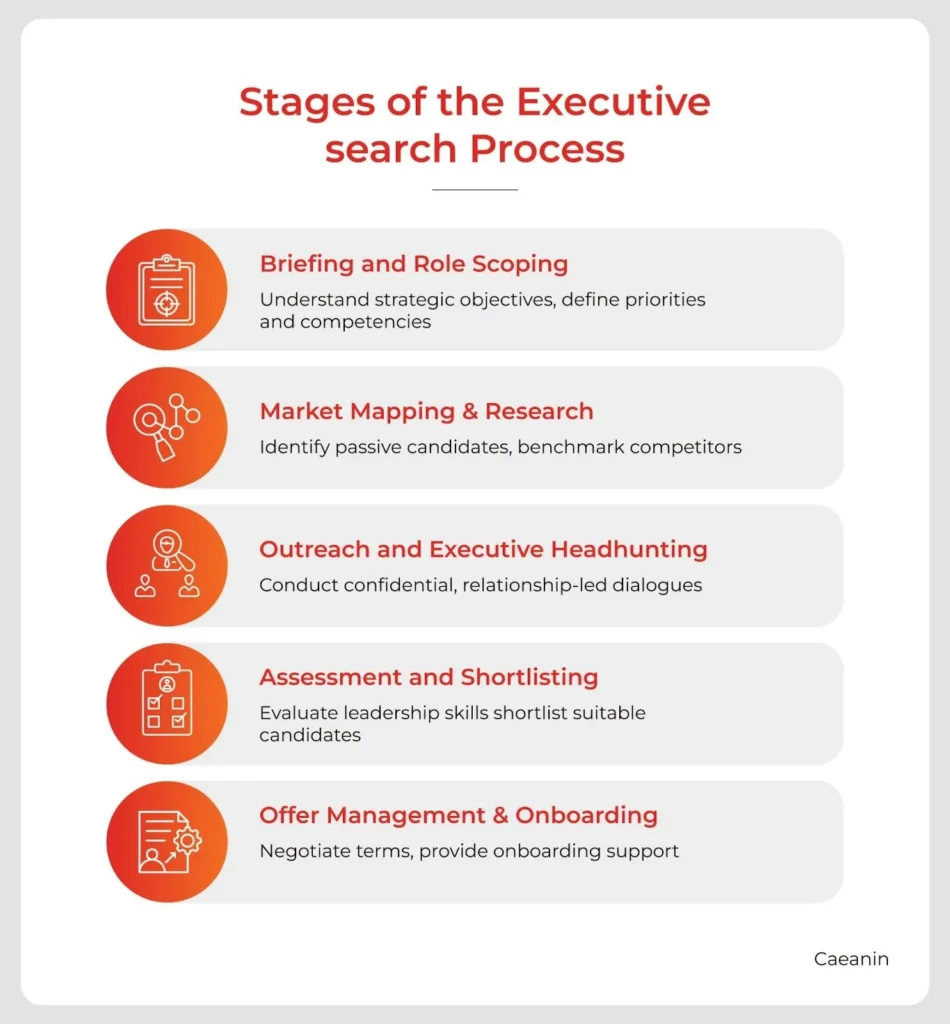Most hiring decisions carry weight. But some carry consequences.
When the role shapes strategy, drives revenue, or represents the company at the highest levels, it demands more than a typical recruitment process.
As noted by Forbes, the best hires happen when firms combine in-depth market research with trusted industry networks
Executive search, also known as retained search or executive headhunting, is built specifically for these high-impact leadership roles. It focuses on identifying, approaching, and securing senior talent who aren’t actively job hunting but have the exact mix of experience, credibility, and alignment required to move a business forward.
This approach is more about precision than posting openings. It’s driven by research, backed by networks, and executed with discretion.
Whether a company is preparing for a CEO transition, building out its leadership bench post-acquisition, or expanding into new markets, executive search offers a structured way to access talent that internal teams often can’t reach and can’t afford to miss.
Why Companies Use Executive Search Services
Hiring for leadership isn’t about volume, but alignment.
When an organization needs a new CMO to reposition the brand or a CFO to guide a strategic merger, you’re not just filling a vacancy. You’re looking for someone who can directly impact growth, steer transformation, or stabilize through uncertainty. That’s why executive search is not an optional tool.
Most recruiting strategies focus on speed and scalability. Executive search flips that lens. Instead of casting a wide net, it narrows the focus to find high-caliber individuals whose leadership style, industry expertise, and values align tightly with the organization’s future.
The aim is not to find ten good candidates, but to land one extraordinary fit.
Why In-House Recruiting Alone Isn’t Enough
Even the best in-house talent acquisition teams face limitations when it comes to executive hiring. Internal recruiters may lack access to senior passive candidates, the credibility to approach them, or the time to conduct deep research.
Search firms, on the other hand, maintain executive networks, proprietary databases, and proven frameworks for mapping hard-to-reach talent. They also act as neutral third parties that are critical when internal dynamics or stakeholder politics make direct outreach complex.
That’s also why executive hiring is rarely transactional. It’s often consultative, with leadership teams engaging search firms as long-term partners to solve deeper talent challenges. That could mean identifying successors before transitions occur, or sourcing future-ready leaders who can navigate digital transformation, ESG mandates, or international expansion.
Some scenarios call for search expertise by default:
- CEO or C-level succession: Often tied to board decisions and investor expectations, these hires demand absolute discretion and long-term impact.
- Confidential leadership transitions: When existing leadership changes can’t be made public, retained search ensures the process stays under wraps while delivering results.
- Cross-border or global hiring: For multinational roles, search firms bring critical understanding of local talent dynamics, compensation norms, and regulatory nuance.
- Turnarounds or new verticals: Startups, spin-offs, and legacy transformations often require leaders with niche skills or playbook experience. These profiles don’t respond to job ads.
The Executive Search Process: Step-by-Step
Executive search is a methodical, multi-phase process designed for precision.
While the specifics may vary slightly across firms, the structure remains remarkably consistent among top executive search providers. And for good reason: predictability, accountability, and stakeholder alignment are critical when you’re hiring for impact.

1. Briefing and Role Scoping
Everything starts with clarity. A thorough briefing goes beyond the job description to understand the organization’s strategic objectives, leadership gaps, team dynamics, and performance expectations. This is where stakeholders align on what success will look like—six months, one year, and three years into the role.
The output is more than a checklist of skills. It’s a calibrated search blueprint, often including:
- Business priorities tied to the role
- Key leadership competencies
- Cultural context and stakeholder dynamics
- Metrics for evaluating success
Without this step, every subsequent decision risks misalignment.
2. Market Mapping & Research
This is where strategy meets data.
Top executive search firms conduct deep market scans, targeting competitors, adjacent industries, and relevant global talent pools. The goal is to identify the best-fit candidates who likely aren’t looking.
This phase typically includes:
- Talent mapping across sectors and geographies
- Competitive benchmarking of compensation and role design
- Identification of passive candidates who match leadership and functional requirements
- Filtering for diversity, succession readiness, or relocation flexibility (if needed)
It’s high-touch, research-driven, and built for precision, not pipeline volume.
3. Outreach and Executive Headhunting
With targets identified, the real outreach begins, but discreetly.
Senior executives don’t respond to cold InMails or job posts. Instead, outreach is relationship-led, confidential, and consultative. This is where the credibility of the search partner plays a defining role. The best executive search firms have access to doors others can’t even knock on.
Approaches may involve:
- Referral networks and industry introductions
- Personalized outreach through retained consultants
- Dialogue designed around opportunity fit, not job availability
At this stage, it’s not about selling the role, but creating interest in the problem to be solved and the impact to be made.
4. Assessment and Shortlisting
Here, rigor replaces assumption.
Shortlisted candidates undergo structured interviews, leadership assessments, and culture-fit evaluations. Many firms use tools like Hogan, Caliper, or custom 360-degree references to assess emotional intelligence, decision-making patterns, and growth mindset.
What matters most isn’t just what the candidate has done, but how they think and whether they can lead in the context the role demands.
The final shortlist typically includes:
- Detailed candidate reports
- Leadership competency evaluations
- Strategic alignment notes for client review
5. Offer Management & Onboarding
Once the client identifies the preferred candidate, the process shifts toward securing the hire and preparing for success.
This stage often includes:
- Compensation and equity structuring (benchmarked against market data)
- Resignation management and counteroffer strategy
- Onboarding advisory, especially for the first 90-day integration
- Relocation and spousal support, where applicable
The search partner stays involved because getting the offer accepted is just one milestone. Retention starts at the offer letter.
How Long Does an Executive Search Take?
There’s no universal clock for executive hiring. But there is a range, and expectations matter.
Most executive search engagements take between 6 to 12 weeks from kickoff to accepted offer. That’s not an arbitrary window. It reflects the depth of research, the complexity of stakeholder alignment, and the time required to engage candidates who aren’t actively looking.
Several factors influence whether your timeline leans closer to six weeks or stretches beyond twelve:
- Role complexity: Niche or transformation-focused roles require tighter fit and broader market scans. A VP of Product is not the same as a Chief Transformation Officer.
- Market dynamics: If you’re hiring in a hot sector, say, AI or renewable energy, you’ll be navigating talent scarcity and counteroffers.
- Geographic scope: Global or cross-border searches may extend the timeline due to regulatory, relocation, or cultural fit considerations.
- Internal decision-making: Delays often stem from within. Misalignment among hiring committees, slow interview scheduling, or evolving role expectations.
At the senior-most levels, like CEO, Chairperson, Board Member, expect a longer runway. These searches typically include:
- Deeper stakeholder involvement (often at the board level)
- Rigorous multi-stage interviews
- Compensation structuring involving equity and long-term incentives
- External advisors or governance reviews
Timelines for these roles can run 3 to 6 months, depending on the complexity and urgency.
It’s tempting to push for speed, especially when leadership gaps are already visible. However, compressing the process too much creates real risks, such as shallow assessment, a limited candidate pool, or premature offers.
A strong search firm will flag when acceleration jeopardizes quality. And experienced TA leaders know: a few extra weeks to land the right executive is worth it. Replacing the wrong one? That takes far longer.
What Makes Executive Search Different from Other Recruitment Models?
Many executive hires fail not due to lack of experience, but because of strategic misalignment or unresolved internal dynamics. Harvard Business Review highlights how these leadership breakdowns often stem from cultural mismatches or lack of trust at the top.
Executive hiring shouldn’t be treated like a higher-stakes version of standard recruitment. It’s a fundamentally different model. From how candidates are identified to how success is defined, executive search operates on a different plane.
Retained vs. Contingent Search
Let’s start with the structure. Most leadership roles are filled through retained search, not contingent hiring. Why?
Because retained search brings:
- Upfront commitment: The client retains the firm exclusively, typically with a partial fee paid at the start. This ensures priority, focus, and confidentiality.
- Deeper coverage: The firm isn’t racing multiple vendors. They invest time in mapping, research, and engagement, rather than betting on speed.
- Strategic partnership: It’s not about filling seats. It’s about understanding strategic goals and aligning talent accordingly.
In contrast, contingent search operates on a success-fee basis. There’s no upfront cost, but also little incentive for depth. It’s fast, reactive, and often focused on volume over fit. Perfect for junior or mid-level roles. Not ideal when the cost of a mis-hire is high.
Headhunting vs. Executive Search
The terms often get used interchangeably. But they’re not the same.
- Headhunting refers to the act of directly approaching candidates, typically passive talent,about a specific opportunity.
- Executive search includes headhunting, but also market research, stakeholder alignment, leadership assessment, compensation advisory, and onboarding strategy.
Why the Distinction Matters
For experienced talent acquisition leaders, this distinction is more than semantics. It’s operational.
Hiring a business unit leader to run an expansion in Southeast Asia? You need more than outreach. You need market context, cultural alignment, risk mitigation, and executive influence. That’s the domain of retained executive search, not opportunistic candidate sourcing.
More than availability, it’s about who’s viable and who will succeed in the context your business demands.
When Should Companies Use Executive Search?
Not every role requires retained search. But when stakes are high, markets are complex, or timelines leave no room for error, executive search becomes the most strategic move.
Here’s when companies typically shift from internal or contingent hiring to a retained search partner.
1. Business Is Entering a New Strategic Phase
Think of scenarios like new market entry, post-merger integration, product diversification and the like. When the business model itself is evolving, you can’t afford to guess on leadership. You need someone who’s not just seen the shift, but shaped it.
That’s not easy to source internally, and job postings won’t attract these candidates. Executive search surfaces leadership profiles with proven relevance and helps pressure-test for fit in a future-facing context.
2. Leadership Gaps Risk Growth or Stability
Sometimes the gap is functional with no CMO to drive demand. Other times, it’s cultural with a lack of cohesion across regions. Either way, unfilled leadership roles cost time, revenue, and team morale. And promoting internally isn’t always viable.
A retained executive search firm brings objectivity. They assess internal readiness but also benchmark externally, giving you data to make a sound call, not just a quick one.
3. The Role Requires High Confidentiality
When leadership changes can’t be made public due to investor sensitivity, internal dynamics, or compliance issues, confidentiality isn’t optional. Retained search firms operate under NDAs, manage controlled messaging, and maintain discretion throughout the process.
This is especially common for:
- CEO transitions
- Executive exits tied to underperformance or restructuring
- Succession planning where timing isn’t public
4. Internal Referrals or Pipelines Fall Short
Even companies with mature HR structures often find their networks drying up when it comes to niche or global leadership roles. The more senior the hire, the smaller the pool and the less likely those people are to be on your radar.
Executive search firms thrive in these blind spots. They know where to look, how to engage, and how to attract leaders who aren’t actively looking.
5. Prior Attempts Have Failed or Delayed Hiring
One of the most common triggers for search? Time lost.
Maybe the role’s been open for 90+ days. Maybe the finalist declined the offer. Or maybe three interview rounds later, no one feels aligned. In these cases, speed becomes urgency, but missteps can’t be repeated.
A strong executive search strategy can recalibrate the brief, reset stakeholder alignment, and relaunch with sharper positioning.
How to Choose an Executive Search Firm
Retained search isn’t a one-size-fits-all solution and neither are the firms that offer it. Choosing the right executive search firm is a strategic decision in itself. When done well, it leads to hires who drive real impact. When rushed, it results in delays, misalignment, or worse, costly mis-hires.
Here’s how experienced HR and talent acquisition leaders evaluate partners.
Evaluation Checklist
Before you sign any agreement, assess the firm across five critical dimensions:
- Specialization in your industry or function
Domain expertise is the baseline (Don’t consider it a bonus). A search partner who understands your market dynamics, organizational nuances, and role expectations will get to qualified candidates faster. - Search methodology and research capabilities
Ask how they define the search strategy, map the market, and screen for fit. Firms with a structured approach to discovery, assessment, and calibration typically deliver stronger outcomes and fewer surprises. - Proven record in strategic hiring
Review past success in leadership hiring for similar companies, stages, or markets. Look beyond names, ask about retained projects, repeat clients, and references tied to outcome, not just process. - Transparency in fees, timelines, and communication
Upfront clarity on cost structure, reporting cadence, candidate ownership, and offer-stage engagement is non-negotiable. You’re not outsourcing recruitment, but engaging a partner. That requires alignment. - Advisory capabilities beyond placement
The best firms advise on more than who to hire. They help you shape the role, benchmark compensation, navigate internal politics, and prepare for onboarding and retention. Especially when hiring into sensitive or ambiguous contexts.
Red Flags to Avoid
Not all firms that claim to do executive search operate at the same level. Watch for these warning signs:
- Overpromising on timeline or outcome
“We can fill this in three weeks” often means cutting corners. Precision takes time, and shortcuts at the top are expensive. - Minimal involvement post-shortlisting
If a firm disappears after sending you a few résumés, it’s not true retained search. You’re paying for depth, not a résumé drop. - Lack of industry references or retained experience
Ask how many searches they’ve completed in your space. Contingent experience doesn’t always translate to strategic hiring.
Benefits of Working with a Top Executive Search Firm
When leadership hiring is tied to strategic growth, regulatory complexity, or global expansion, shortcuts come with consequences.
That’s where the value of a top executive search firm becomes clear, not just in who they bring to the table, but in how they shape the entire hiring process.
Access to Passive, High-Impact Talent
The best candidates rarely apply. They’re busy leading, building, scaling, usually with no intent to move. Top executive search firms specialize in engaging this passive market. They don’t just “find people.” They know how to frame opportunity in a way that resonates with leaders who aren’t looking, yet are open to the right challenge.
This is especially critical for:
- Niche technical or transformation roles
- C-level hires requiring vision, not just experience
- International or cross-market positions
Confidentiality in Sensitive Transitions
Leadership changes aren’t always public or simple. Whether you’re replacing a founder, addressing underperformance, or restructuring quietly before a public announcement, discretion is non-negotiable.
Search firms operate under strict confidentiality protocols. Outreach is controlled. Narratives are consistent. And the risk of market speculation, competitor attention, or internal disruption is dramatically reduced.
Support for Diversity and Inclusive Leadership
Top firms incorporate DEI goals directly into their sourcing and shortlisting process. That means widening talent pipelines, removing bias from assessment, and presenting slates that reflect both representation and relevance.
If you’re serious about inclusive leadership, not just diverse optics, this kind of structured sourcing is essential.
Global Reach and Local Understanding
Multinational organizations can’t afford cultural mismatches or misaligned compensation. Leading executive search firms have on-ground networks in key talent hubs and understand the nuances of global hiring, compensation structures, relocation policies, local norms, and leadership expectations.
They help balance the global and the local, without compromise.
Reduced Risk Through Structured Vetting
Mis-hires at the executive level are costly. In both time and trust. Top search partners mitigate that risk through:
- Psychometric and leadership assessments
- Structured stakeholder alignment
- Cultural compatibility evaluation
- Counteroffer and retention risk analysis
They don’t just vet candidates, but pressure-test fit and help set leaders up for long-term success.
Executive Search Strategy in 2025
The executive search model isn’t static, and neither is the leadership landscape. As companies evolve in response to global disruption, digital transformation, and shifting workforce expectations, the strategies behind executive search have grown more adaptive, data-driven, and forward-looking.
It’s no longer just about qualifications. It has moved to focus on potential, resilience, and alignment with what comes next. As leadership expectations evolve, frameworks like MIT Sloan’s New Leadership Playbook for the Digital Age show that traits such as digital fluency, empathy, and adaptability are now central to leadership success, not just desirable add-ons.
- Leadership Roles Designed for Adaptability
Static job descriptions no longer cut it. Today’s executive roles are fluid by design, especially in high-growth sectors or companies navigating uncertainty. Search partners now help define roles not just based on what the company needs today, but on how those needs may shift in 12–24 months.
This shifts the focus from matching résumés to finding adaptable leaders who can grow with the business.
- Emphasis on Emotional Intelligence and Soft Power
As organizations flatten and stakeholder ecosystems grow more complex, emotional intelligence (EQ) has become as important as IQ. Especially in roles involving transformation, integration, or cross-functional influence, firms are assessing:
- Empathy and listening skills
- Change management capacity
- Conflict resolution in matrixed environments
These attributes are now part of structured assessment rubrics, not just interview impressions.
- AI-Enabled Cultural Alignment
Cultural fit has always mattered. But in 2025, it’s finally measurable.
Top executive search firms are incorporating AI tools and behavioral analytics to assess culture alignment at both the team and organizational levels. Think sentiment analysis, predictive modeling, and decision-making style assessments.
The result? AI-powered candidate matching is enabling fewer mis-hires due to mismatched values. Better onboarding. Higher retention.
- ESG, DEI, and Future-Readiness as Core Criteria
Companies aren’t just hiring for performance, but representation, responsibility, and resilience. That means executive search now includes:
- DEI-informed sourcing strategies
- ESG literacy as a leadership trait
- Readiness for digital, regulatory, and societal shifts
Leaders are, thus, being assessed not just on what they do, but on how they lead, who they include, and what future they’re helping to build.
Conclusion: Strategic Hiring Begins with the Right Leadership
Leadership defines momentum. In times of change, expansion, or reinvention, the right executive sets the direction. Executive search offers more than access to talent. It brings market intelligence, clarity of fit, and a competitive edge in boardroom decisions.
For experienced HR and TA leaders, working with a retained executive search partner is a strategic move. The cost of delay or a mis-hire at this level is too great to leave to chance.
If your next hire could shift your company’s trajectory, don’t rely on luck. Rely on expertise.
SPECTRAFORCE supports organizations in identifying, engaging, and onboarding executive talent that drives results. With deep industry experience, access to top global talent pools, and a strategic, research-backed approach to leadership hiring, our executive search team is built to support critical business transitions.
Whether you’re seeking a visionary CTO, a transformation-ready COO, or succession planning for your next CEO, contact SPECTRAFORCE to combine speed, strategy, and discretion to deliver impact-ready leaders.
FAQs
Executive search is a specialized form of recruitment focused on hiring senior-level executives for high-stakes roles, typically in the C-suite or other leadership functions. An executive search firm takes a proactive approach, identifying and engaging passive candidates who aren’t actively seeking new roles but are highly qualified. The process is research-driven, consultative, and tailored to align with the organization’s strategic goals.
Choosing an executive search firm requires more than a quick credentials check. The best firms combine deep industry knowledge with a clear, repeatable search methodology. Look for a proven track record in leadership hiring, especially in your domain or sector. Assess how they approach cultural alignment, diversity hiring, and stakeholder communication. Transparency around timelines, pricing, and candidate ownership is equally important. A strong fit means they function as a strategic hiring partner, not just a vendor.
Executive search typically takes between 6 and 12 weeks from kickoff to offer acceptance. However, this timeline depends on multiple variables: the complexity of the role, geographic constraints, internal alignment among decision-makers, and the availability of qualified talent. Highly specialized or confidential searches, such as for a CEO or board member, can take longer due to more rigorous due diligence and stakeholder involvement.
Companies should consider executive search services when the role is critical to strategic execution or long-term growth. Common triggers include leadership transitions, business expansion, M&A events, or succession planning. Executive search is particularly valuable when internal talent pipelines are insufficient, confidentiality is paramount, or the role requires niche expertise that’s not accessible through traditional recruitment channels.
Headhunting typically refers to the act of directly approaching potential candidates(usually for a specific role) without advertising. It’s a tactic. Executive search, on the other hand, is a full-service process. It combines headhunting with structured market research, competency-based assessments, stakeholder alignment, and onboarding consultation. In short, executive search is broader, more strategic, and built for leadership outcomes, not just hires.



